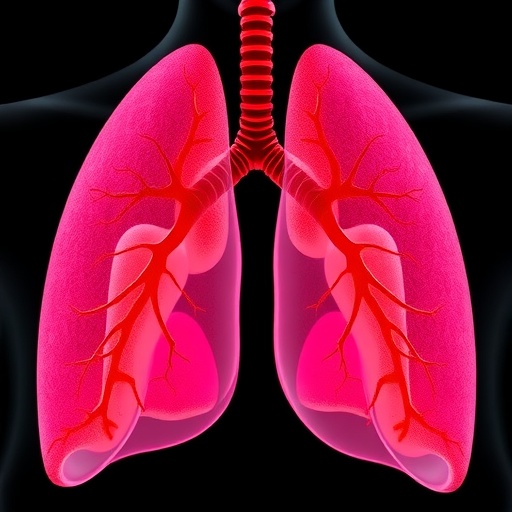In a revolutionary advancement in biomedical engineering, researchers have developed an innovative “lung-on-a-chip” model, which possesses the capability to simulate the severe immune response to influenza infections in humans. This breakthrough is expected to pave the way for enhanced understanding and treatment of respiratory viral infections, particularly during an era where influenza continues to pose significant global health threats. The intricate design of this immune-competent chip bridges the gap between traditional cell culture studies and in vivo models, offering a more dynamic and realistic environment for studying the intricate interactions between viruses and human lung tissues.
The lung-on-a-chip technology employs microfluidic systems that replicate the physiological conditions of human lungs. This model not only supports human lung cells but also integrates immune cells to create a more holistic representation of lung functionality. The invention is particularly significant given the intricacies of the immune response to influenza, which can lead to severe respiratory complications. This model offers researchers the capacity to investigate these responses at both cellular and molecular levels, enabling a closer examination of the pathogen-host interaction.
In their recent study, the researchers, including Ringquist, Bhatia, and Chatterjee, have meticulously detailed the fabrication and operational parameters of their lung-on-a-chip device. The chip is designed to facilitate the flow of air and immune cells, akin to the natural flow within human lungs. Such a set-up allows for real-time monitoring of cellular responses to viral infections, potentially leading to insights into how the immune system reacts under severe influenza conditions. This capability is crucial for dissecting the immunopathology associated with various influenza strains, which often vary in virulence and transmissibility.
A particular highlight of this research is the multifunctionality of the lung-on-a-chip. By enabling the simulation of both viral infection and immune response, researchers can observe the impacts of various therapeutic interventions in a controlled environment. For instance, the model can be used to test antiviral drugs or vaccine candidates, providing invaluable preclinical data that could streamline the transition to human trials. This approach has the potential to significantly shorten the drug development timeline, offering new hope for timely interventions against influenza outbreaks.
The incorporation of immune cells into the lung-on-a-chip model further amplifies its relevance in modern biomedical research. Traditional models often overlook the contributions of immune responses in disease progression, leading to a lack of understanding of their roles. By embedding these immune cells within the chip, researchers can monitor cytokine release, cell signaling pathways, and other immune interactions as they occur in real-time, generating a wealth of data that can inform both basic science and clinical applications.
Additionally, the team demonstrates the ability to model different respiratory conditions, adjusting parameters such as airflow and pressure to mimic disease states more accurately. This versatility opens avenues for not only researching influenza but also other respiratory pathogens, including coronaviruses and bacteria, enabling the creation of comprehensive studies on respiratory infections as a whole. The implications for public health are profound, as this technology can inform vaccine development and epidemic preparedness strategies.
Moreover, the lung-on-a-chip technology is poised to reduce the reliance on animal models, addressing significant ethical concerns in biomedical research. By providing a reliable alternative that mirrors human physiology more closely than traditional animal models, researchers can conduct studies with a more humane approach, all while gathering data that is more applicable to human health. This shift in paradigm aligns with the move toward human-centered research methodologies in biomedical fields.
The initial experiments conducted using this novel lung-on-a-chip have already yielded promising results, elucidating the cellular dynamics in response to influenza infection. Early data indicate that the model successfully mimics the inflammatory responses observed in infected human lungs, characterizing the release of specific immune mediators that contribute to disease pathology. These findings not only reinforce the accuracy of the lung-on-a-chip model but also validate its potential for uncovering insights into viral pathogenesis.
Further investigations using the device will be oriented towards understanding the differential responses of various influenza strains. Given the ongoing evolution of influenza viruses and their capacity to mutate rapidly, a model that can simulate these variations may be crucial in anticipating how new strains could affect public health. The ability to swiftly adapt the chip apparatus for different viral strains could lead to significant advancements in vaccine formulation and antiviral treatments.
The integration of cutting-edge imaging technologies with the lung-on-a-chip offers an additional dimension to the research capabilities. Techniques such as live-cell imaging can be employed to visualize interactions at the cellular level, providing an unprecedented view of the cellular mechanisms in play during an influenza infection. This level of detail could illuminate previously hidden aspects of viral pathology and will likely lead to groundbreaking discoveries in the field of immunology.
As the research community begins to explore the full potential of the lung-on-a-chip technology, collaborative efforts among scientists, clinicians, and policymakers will be essential. Sharing data across institutions will accelerate knowledge transfer and inspire innovative approaches to tackling viral infections. Ultimately, by uniting multiple disciplines around this platform, the scientific community can deepen its understanding of respiratory diseases and foster the development of more effective interventions.
In conclusion, the development of an immune-competent lung-on-a-chip currently signifies a significant leap forward in modeling human respiratory responses to influenza. By providing a realistic, controlled environment for studying viral infections and immune reactions, this groundbreaking research lays the groundwork for future explorations into respiratory diseases. The implications of this technology extend far beyond influenza, presenting an opportunity to fundamentally change how researchers approach studies of viral infections and their corresponding immune responses. The potential to expedite drug development and enhance our understanding of respiratory health and disease make the lung-on-a-chip a prominent topic in the realm of medical research.
Subject of Research: Immune-competent lung-on-a-chip for modeling severe influenza infection response.
Article Title: An immune-competent lung-on-a-chip for modelling the human severe influenza infection response.
Article References:
Ringquist, R., Bhatia, E., Chatterjee, P. et al. An immune-competent lung-on-a-chip for modelling the human severe influenza infection response.
Nat. Biomed. Eng (2025). https://doi.org/10.1038/s41551-025-01491-9
Image Credits: AI Generated
DOI: 10.1038/s41551-025-01491-9
Keywords: lung-on-a-chip, influenza, immune response, viral infection, biomedical engineering.
Tags: advanced respiratory disease researchbiomedical innovation in health threatsdynamic cell culture environmentshuman lung tissue interactionsimmune response to influenzaimmune-competent chip designinfluenza complications researchlung-on-a-chip technologymicrofluidic systems in biomedical engineeringpathogen-host interaction studiesrespiratory viral infections modelsevere influenza simulation





